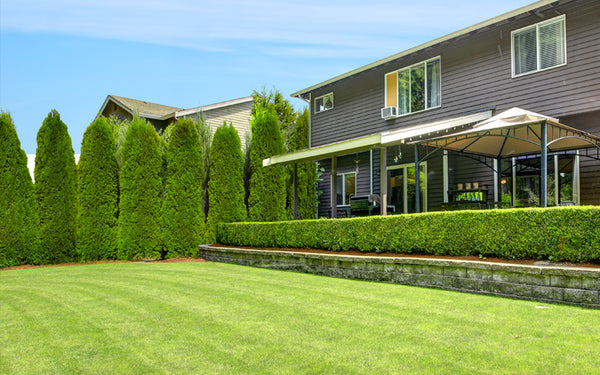Thujas: Green Giants vs. Emerald Greens

Last updated: May 11 2022

While it may not seem like there could be much of a difference between different varieties of the same plant, the Thuja Green Giant and Emerald Green Thuja actually have striking features that will have different impacts on the look of your landscape.
The Similarities and Differences Among Thujas
Thuja Green Giants get their iconic name by growing up to massive heights between 20 to 40 feet. They also spread out and grow to be about 12 to 20 feet wide. The Green Giant is better suited for areas with a lot of space to fill in, so if you have more ground to cover, consider this large Thuja.
Emerald Green Thujas are perfect for smaller landscapes because they only grow to heights between 8 and 12 feet. They have a much smaller spread, growing about 3 to 4 feet wide. Emeralds will fit better in tight spaces around the driveway or property borders, and their smaller size makes them ideal to grow in containers.

Growing Zones for Thuja Trees
If you're looking for an evergreen that can stand up to the cold and harsh winter weather, check out the Emerald Green Thuja. It's recommended for growing zones 3 through 8 and can survive freezing temperatures that dip down to -40 degrees.
Thuja Green Giants can handle snow and ice, but not at the same level as Emerald Greens. Green Giants are recommended for growing zones 5 through 9, and can withstand freezing temperatures down to -20 degrees, so they still grow extremely well in northern areas. However, Thuja Green Giants are an excellent option for hot areas - they'll happily flourish in dry, southern areas that other evergreens can’t handle.
What Are Thuja Green Giants?
Thuja Green Giants are very attractive with dense, dark green foliage. They provide a dark background for flowering trees and shrubs to pop against. Plus, Green Giants have large, wide bases and grow narrower towards the top, giving them a pyramidal shape that causes them to look like giant Christmas trees.
Emerald Green Thujas have a brighter green glow, causing them to shine with a bright green hue in the sunlight. They have a more columnar shape with the same width almost from the ground up before narrowing towards the top.
The Similarities Between Emerald Green Thujas and Thuja Green Giants
Toughness
Both Thuja Green Giants and Emerald Thujas have an extremely high resistance to pests and diseases. While other evergreens often fall prey to bagworms or spider mites, along with molds and fungi, Thujas fight them!
They also stand up to extreme weather conditions, and their strong, upright branches won’t snap under heavy layers of snow and ice. With a high level of drought tolerance, they'll withstand heat waves and dryness brought on by cold, winter winds.
What's more is that Thujas aren’t picky about their soil. They'll thrive in a variety of poor soils, ranging from ones that are acidic and sandy to poor-draining and heavily clay-based.

Growth Rate and Low-Maintenance
There isn’t any waiting around when it comes to Thujas. Green Giants and Emeralds both have growth rates of up to five feet per year, so they'll quickly grow into large, mature trees.
Forget the watering and feeding schedules because Thujas don’t need them! With an adequate amount of water, they’ll grow big and strong on their own. They also don’t have a need for fertilizers or pest sprays.
Plus, don’t worry about Thujas growing too large - while it’s true that Green Giants can reach monstrous heights, they're also easy to shape and maintain. Emeralds and Green Giants can easily be shaped into hedges and kept at certain shapes and sizes as desired.
Thujas are an all-around solid landscape choice, and whether you choose the Green Giant or the Emerald Green, you'll be glad you did! Learn more about these Thujas and others in our full Thuja Tree Collection.
FAQs

Written by
Blair Brown
Blair is the Content Marketing Manager at FastGrowingTrees.com, and though she's not your traditional gardener, the planting world is definitely growing on her (pun intended!). She's enjoyed digging into plant care and maintenance and growing her plant collection, especially with exotic indoor varieties.
Featured Product

Thuja Green Giant Arborvitae
3107 reviewsStarting at $19.95






















































































































































































































































